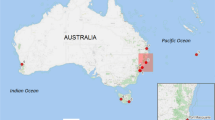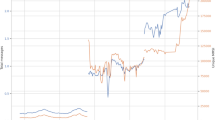Abstract
Japan was more dependent upon ocean shipping than any other major power during World War II, and the sea route had been the only means of transportation between Korea and Japan. The connecting steamers contributed to Japan’s wartime economy by transporting not only raw materials, but also forced laborers and sex slaves between Korea and Japan. More importantly, these connecting steamers were linked to railroads and land routes in Korea and were connected to various systems of transportation, including merchant ships and regular liners outside Japan. In this paper, we examine how Korean laborers and sex slaves were mobilized and transported from Korea to Japan during World War II by focusing on the interdependent relations between railroad-connecting ships and a travel agency.
Similar content being viewed by others
Notes
For the most recent introduction to these problems and a discussion of responsibility and reparation, refer to the international conference “50 Years of Denial: Japan and Its Wartime Responsibilities,” Sept. 6–9, 2001, organized by the University of California, Berkeley (Asian American Studies, Dept. of Ethnic Studies and the Rape of Nanking Redress Coalition, San Francisco) in memory of the 50th anniversary of the San Francisco Peace Treaty in September 2001. See also the International Conference on Japanese Crimes Against Humanity: Sexual Slavery and Forced Labor, Ethnic Studies, UC Riverside (Los Angeles, November 29–30, 2001).
The United States inaugurated the Nazi War Criminal Records Interagency Working Group (IWG) in 1999 to solve problems related to war crimes during World War II. The basic functions of the IWG include confirming the existence of documents in U.S. custody related to war criminals, war crimes, infringements upon people’s rights and economic exploitation by Germany and Japan, and if there are any secret documents, encouraging the owning authorities to release them and publicize related documents. It is noteworthy that since May 23, 2000, Japanese war crimes have also been included as a subject of investigation. The IWG concluded its activity in March 2007.
However, relatively abundant research has been completed regarding the problem of transporting American war prisoners, as group transportation in a military context lends itself more readily to historical investigation. For this matter, refer to [2, 7, 8] and reference materials suggested therein. This study on the transportation of forced laborers is the first of its kind. However, being restricted by time and materials, this study confines itself to an introduction of a contemporary view of the problem. Full-scale research on this subject remains a task for the future. Given the connection between war crimes of the Japanese government and businesses on the one hand and the problem of transportation on the other, the prospect of future research is not discouraging. Because of Japan’s geographical situation, Japanese wartime transportation was characterized by maritime activity, and the nation consequently possesses abundant records of its maritime business.
Shipbuilding yards began construction in earnest after 1853, when the Ordinance for the Prohibition of Large Ships was withdrawn. In that year, Commodore Perry forced the Japanese to open up their country. Tokugawa shoguns fully realized the necessity of marine defense and started to construct shipyards in Yokohama, Kobe, Nagasaki and other cities under the direction of such countries as England. These shipyards came into civilian hands in the Meiji era and still exist today.
The Japanese did not give the names of passenger ships to the connecting ships. The connecting ships only played a role in linking railroads on the Japanese mainland to the Seoul-Busan line on the Korean peninsula.
Total extension was 256.3 kilometers. The 39.9-kilometer Daejon-Yonsan line opened on July 11, 1911, and a railroad-opening ceremony was performed in Mokpo on January 22, 1914.
This opened on September 6, 1914, and extended 222.7 kilometers.
The 199.5-kilometer Cholla line was a railroad running through Honam. It was first constructed as a private narrow-gauge railroad by Chonbuk Railroad Ltd., but was purchased by the Chosun Government-General in October 1927 and renamed the Northern Seoul-Chonju Line Private Railroad and reconstructed with standard gauge. Then the Iri-Yosu line was constructed from the Chonju district, and the Chonju-Namwon line, the Namwon-Koksung line and the Koksung-Sunchon line opened in October 1931, October 1933 and December 1936, respectively. All these lines connected to the Kwangju line in Sunchon. As a result, all serviced areas became connected, and the name was again changed to the Cholla line.
The Japanese railroad initiated operations in 1872. The Railroad Board of the Ministry of Construction exercised its jurisdiction from this time until 1902. Then the Department of Railroad Works oversaw operations until 1907. In the meantime, the railroad nationalization law was reinforced on December 1, 1906, and private lines were nationalized. From 1907 to 1908, the Imperial Bureau of Railroads exercised its authority, as did the Office of Railroads from 1908 to 1920. The office changed its name to the Ministry of Railroads and continued to operate until 1949. The National Railroad, which had been under the authority of the Ministry of Railroads until 1949, transformed into the National Railroad of Japan, a public enterprise that persisted until 1987. On April 1, 1987, the National Railroad of Japan was privatized due to chronic fiscal deficits. It was divided into six passenger railroads and one freight railroad and exists as such at the present time.
However, the Bill to Nationalize Railroads was passed, and Sanyo Railroad’s Busan-Shimonoseki line was purchased by the State. Ships and employees as well as the rights to transport were transferred to the National Railroad.
From the first connecting ship voyage until the early Showa period, a smooth increase in transportation activity was recorded. Freight carriage shifted from marine to rail transport during World War I, then marine freight decreased dramatically during the Great Depression of 1929. Freight carriage by connecting ships, however, recovered with the outbreak of the Manchurian Incident.
In 1904, one year before the connecting ships began services, Sanyo Railroad placed an order with Mitsubishi Shipbuilding for two large crossing liners. They were to be the company ships of the Kyungbu Railroad. To journey to Korea, Japan had to use small ships of about a few hundred tons; shipping capacity was also limited by the harsh waves of the Korea Strait.
Maeilshinbo [Maeil Daily Newspaper], June 29, 1941. In accordance with Article 4 of the Association of Korean Labor, the office was placed within the Chosun Government-General.
JTB is the Japan Transportation Bureau and has existed under various names since 1912. Its website (http://www.jtb.co.jp) includes an English section and briefly introduces its history. However, except for a reference to its name change in 1945, it reveals nothing of its colonial role. The JTB was known as the Doa Travel Agency in 1942, the Doa Travel Company in 1944, and was finally transformed into the Japan Transportation Bureau immediately after the liberation of Korea. The Doa Travel Agency had its Headquarters in Tokyo, branches along the main transportation arteries of Korea and Japan, and information booths in small cities. We know for a fact that those branches belonged to the department of transportation of the Railroad Bureau, and that ships and railroads at that time were under a unified transportation system.
The earlier connecting ships were named after islands near Japan such as Iki and Tsushimamaru. Later, the approximate names of ancient Korean kingdoms and palaces, such as Korrai, Shiragi, Keihuk, Dokuju and Shokeimaru, were used in naming ships. In the late period of the connecting-ship era, ship names were derived from Manchurian mountains, as in the Konronmaru, and from Himalayan mountains, as in the Tensanmaru (from Mount Tensan). The names of connecting ships revealed Japan’s ambition to invade the continent.
This was called the Kwanryo connecting ship. Among the ships in service was the Yosumaru, which was a small ship about one-third the size of connecting ships that traveled between Busan and Shimonoseki; it had second- and third-class compartments, with none of the first-class variety. The sea route from the Kwanmon Cape in Shimonoseki to Yosu took 15 hours to cover and was connected to the Cholla rail line.
The transportation capacity of the Busan-Shimonoseki route was overburdened by an increase in two-track lines and the seating capacity of quay and land facilities in the city of Shimonoseki. Accordingly, a new communication route between Hakada and Busan was established as an auxiliary route in 1943, with two sister ships, the Dokujumaru and Shokeimaru, covering this route beginning July 15. As the war progressed, the auxiliary route played an important role in transportation between the continent and Japan. When the route opened, the central quay of Hakada Port had to be expanded 160 meters to the east in order to accommodate the surge in capacity. (Currently, no traces remain of the quay, and the neighborhood became a yard for railroad containers.)
Misses H, I, R, J, P and C, sex slaves, were conveyed to Pyongyang and Shinuiju as well as to Bongchun and Harbin in Manchuria and Chunjin in China; they most likely used this railroad. Refer to Military Sex Slaves Taken to China (1995) for the testimonies.
Many other women also testified regarding the names of ships they boarded to travel to Japan and elsewhere. Please see vol. I-V for additional information.
Confirmation needs to be performed in the future.
Unfortunately, many sex slave witnesses do not clearly remember the names of ships or the shipping routes of the institutions that transported them.
Please see vols. I-V of [10].
Gregory F. Michno uses the term “hellships” to describe the experiences of American POWs during World War II [7].
References
Jerome B. Cohen, Japan’s Economy in War and Reconstruction (Minneapolis: University of Minnesota Press, 1949)
Linda Goetz Holmes, Unjust Enrichment (Mechanicsburg, PA: Stackpole Books, 2001)
Tatsuro Hurukawa, 100 Years of Railroad-Connecting Ships in Japan, (Tokyo: Seizando Shoten, 2001)
Misae Ikeda, Taiheiyo Senso Sinbotsu Kansen Itai Tsousa Daikan [A Study of Sunken Ships During the Pacific War] (Seizando Itai Zuyou Linkai, 1977)
Min Young Kim, Iljei Chosenin Rodongruok-Eui Sutal Yongu [A Study on the Exploitation of Korean Labor Under Japanese Colonialism] (Seoul: Hanul, 1995), p. 41–66
Byungju Lee, Kwanbu Renrakusen [Kwanbu Connecting Ships] (Seoul: Donga Publishing, 1972), p. 131–132). This novel was originally published by Shinkumunwha in 1972
Gregory F. Michno, Death on the Hellship (Annapolis, MD: Naval Institute Press, 2001)
Yuki Tanaka, Hidden Horrors (Boulder, CO: Westview Press, 1996)
United States Strategic Bombing Survey, The War Against Japanese Transportation 1941–1945 (Washington DC: Transportation Division, 1947), p. 84
Chongsindae Yon’guhoe and Chongsindae Munje Taechaek Hyopuihoe, eds. Kangje-ro Kkullyogan Chosonin Kunwinpudul [Forcibly Recruited Korean Military “Comfort Women”], vol. I. (Seoul: Hanul, 1993)
Acknowledgements
We are indebted to many individuals and organizations in the course of researching and writing this article. A grant from the Ministry of Gender Equality, Republic of Korea, provided some of the initial support. In particular, we also would like to thank Professor Chin Sung Chung of the Seoul National University who provided invaluable support and encouragement for this research project. The author would like to thank the reviewers for their comments.
Author information
Authors and Affiliations
Corresponding author
Rights and permissions
About this article
Cite this article
Chang, E.T., Kim, M.Y. Transportation of Korean Slave Laborers During World War II: Kanfu Ferries. East Asia 24, 69–85 (2007). https://doi.org/10.1007/s12140-007-9002-3
Received:
Revised:
Accepted:
Published:
Issue Date:
DOI: https://doi.org/10.1007/s12140-007-9002-3




